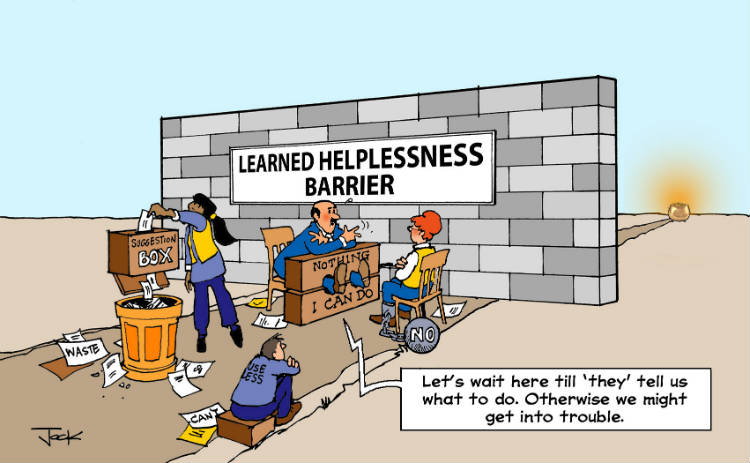How to Overcome Learned Helplessness in Organisations?

Observing many companies, we often find four big cultural barriers – complacency, low expectations, learned helplessness, and passive acceptance. So far we have discussed complacency and low expectations. These two cultural barriers come from employees’ beliefs about the organisation. The next cultural barrier, learned helplessness comes from employees’ beliefs about themselves, their role in the organisation and their ability to personally influence change.
Learn About How to Overcome Complacency in Your Organisation
What is Learned Helplessness?
Learned helplessness is a belief among leaders and teams that they cannot influence change. It is learned, because very few people come in to a job, particularly a leadership role, believing that they will be unable to change things. New employees are often told by their colleagues that there is “no point asking because nothing will ever change”. This belief is developed over time by management refusing to accept or listen to ideas or even completely ignoring the ideas of their staff. After a very short time the team will simply stop making suggestions and sharing ideas and just put up with whatever problems they are experiencing.
Learned helplessness is reinforced by poor communication. Therefore, if there are not good conduits for a team to communicate their ideas and concerns then it is likely they will never be heard, reinforcing the feeling of helplessness. Learned helplessness can exist at all levels of an organisation. I often hear Lean Managers or even Factory Managers complaining that they cannot implement Lean because Senior Management is not on board.
Why is Learned Helplessness a Problem?
Learned helplessness reinforces the “eighth waste” – under utilised human potential. When people believe that they have no influence and their ideas will not be listened to, they stop sharing their ideas and contribute less to the success of the business. Worse, the belief that employees cannot change things can lead teams to put up with some really terrible things. Dangerous, unhealthy and costly problems can continue until they lead to serious consequences such as a serious accident. At which point everyone admits that they knew about the problem, but did not believe they had the power to influence it or that those who could influence it would not listen to them.
Learn How To Beat a Culture of Low Expectations
Overcoming Learned Helplessness
In many ways, learned helplessness is the easiest of the four cultural barriers to overcome. You simply need to demonstrate to the team that they can influence change, that their concerns and ideas will be acted on. Once people start to see that they can make a difference it will often open a floodgate of ideas. It is therefore important to be prepared for this and have resources and good systems to communicate what is happening with ideas. Often companies will use suggestion schemes to collect staff ideas.
These can work well, but more often prove difficult to sustain and can even make the learned helplessness problem worse when employees see that suggestions continually get ignored, rejected or it takes forever for them to get acted on. More effective is to create a system of daily routine communication such as the Lean Daily Leadership Process backed up by some simple tools for Solving Problems Every Day. This approach makes the team part of assessing the idea and developing and implementing the solution and creates some empowerment and accountability in the team for changing their own work area – the ultimate antidote to learned helplessness.
Overcoming Learned Helplessness as a Lean Practitioner
If you are a Lean practitioner and are feeling helpless, then you are not going be very effective. To start with you need to recognise first that your very employment represents some evidence that the business does support the need to implement Lean. Often, we have seen Lean transformation start in the middle of an organisation, not the top. Find a line manager who wants help and is open to work with you. Find a problem you can help them with and apply Lean to overcome that problem.
Publicise your results and make sure that the manager who trusted you gets lots of credit. You will get credit too, but by getting recognition for the project sponsor you will encourage other managers to step forward and sponsor projects. Repeat this process and you will gradually build a track record of success and critical mass of support for change that the most senior managers will not be able to ignore.
Next month we will talk about the last of the big four cultural barriers, passive acceptance. While the first three, complacency, low expectations and learned helplessness are about beliefs, passive acceptance is about leadership behaviours. Leaders demonstrate passive acceptance when they ignore substandard performance or work practices. We all know that “the standard you walk past is the standard you accept” and therefore if we walk past low standards we accept and entrench them – that is passive acceptance. Catch up with our blog next month to learn more.
Read Our Lean Culture Series of Blogs
Overcoming Four Big Barriers to a Lean Culture Part 1: Breaking Through Complacency
Overcoming Four Big Barriers to a Lean Culture Part 2: Beating Low Expectations
Overcoming Four Big Barriers to a Lean Culture Part 3: Overcoming Learned Helplessness
Overcoming Four Big Barriers to a Lean Culture Part 4: Stopping Passive Acceptance
What is learned helplessness?
Learned helplessness is a theory first proposed by Martin Seligman in the 1970s. The theory suggests that when people feel they cannot control their environment or the outcome, they become resigned to their fate and give up trying. It can lead to a spiralling effect where people become increasingly unmotivated, powerless, and ineffective.
In an organisational context, learned helplessness embodies a behavioural pattern involving various maladaptive responses characterised by avoidance of challenges and complete shutdown of problem-solving strategies in times of difficulty. It can manifest itself in low morale, high turnover, and absenteeism. It can also lead to apathy and a general unwillingness to engage with the organisation.
Managers need to be aware of the signs of learned helplessness in their team and work to create an environment where people feel like they can make a difference.
What are the 3 elements of learned helplessness?
There are three primary elements of learned helplessness. These are:
- Contingency
- Cognition
- Behaviour
- Contingency
Contingency is the degree to which people feel they can control their environment. When people feel like they have no control or believe they cannot influence the results of their actions, despite their efforts, they are more likely to experience learned helplessness.
Contingency occurs in organisations when employees feel like the management does not listen to their ideas and concerns or recognise their work. It can lead them to shut down in communication, where workers cease to care about their job or the organisation as a whole.
- Cognition
Cognition is how people process and make meaning of their experiences. When people feel like they cannot understand or make sense of what is happening around them, they are more likely to experience learned helplessness. It often occurs in organisations when the management does not engage employees when making changes or decisions. It can lead to confusion and frustration, further contributing to a spiral of learned helplessness.
- Behaviour
Behaviour is how people act in response to their environment. Thus, learned helplessness prevails in situations without observable contingency or visible end. Such a state leads people to behave accordingly by ceasing all attempts to take control and instead adopting a passive outlook of the tasks at hand. The behaviour manifests as absenteeism, low productivity, and high turnover.
The Effects of Learned Helplessness on Organisational Behavior Stress
Learned helplessness is the belief that one cannot avoid or escape a negative situation because one lacks the necessary skills or resources. This can lead to feelings of powerlessness, anxiety, and depression. In turn, these feelings can lead to unhealthy coping mechanisms such as substance abuse, self-harm, and suicide.
Learned helplessness can also negatively affect job performance and satisfaction. Employees who feel hopeless are less engaged in their work and more likely to experience burnout. Additionally, learned helplessness can hinder teamwork and collaboration. When people believe that they cannot influence the outcome of a situation, they are less likely to put forth the effort or contribute their ideas. As a result, organizations with high levels of learned helplessness tend to be less productive and creative.
Additionally, learned helplessness can create a toxic workplace environment by breeding cynicism, apathy, and mistrust. Therefore, it is important for organizations to be aware of the effects of learned helplessness and take steps to prevent it.
Learned Helplessness in Organisations
In any organization, there will always be those who are resistant to change. They may be comfortable with the status quo, or they may simply be afraid of the unknown. Whatever the reason, their resistance can have a very real impact on productivity and morale. One of the most insidious effects of resistance is learned helplessness.
Learned helplessness is a condition in which people believe that they are powerless to change their circumstances. Once someone has internalized this belief, they will often give up even before they’ve tried to effect change. This can have a devastating effect on an organization, as it effectively destroys any motivation to improve or innovate. Managers need to be aware of the signs of learned helplessness and work to prevent it from taking hold. Only by creating a culture of initiative and empowerment can an organization hope to thrive.
How do you overcome learned helplessness at work?
Learned helplessness is a psychological condition that can occur in any area of life, including work. It occurs when someone believes that they are powerless to change their circumstances, even when there is evidence to the contrary. As a result, they may give up on trying to improve their situation, resulting in a downward spiral of resignation and low productivity. Overcoming learned helplessness requires recognizing that it is a product of your own thinking. Once you realize that you are capable of taking control of your circumstances, you can begin to make positive changes. This may involve seeking out new challenges, learning new skills, or simply changing your outlook on work. Whatever approach you take, overcoming learned helplessness is essential for achieving success in work and in life.





